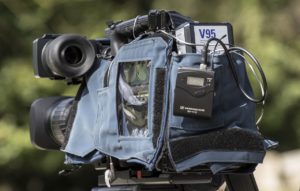 According to recent data collected by public opinion research firm Gallup and the Broadcasting Board of Governors, television use is finally overtaking radio use in Afghanistan for the first time ever in the country.
According to recent data collected by public opinion research firm Gallup and the Broadcasting Board of Governors, television use is finally overtaking radio use in Afghanistan for the first time ever in the country.
Although many Afghans continue to use radio as their primary means of receiving news, information, and entertainment, television viewership has seen huge strides over the past few years, thanks in part to the increasing number and accessibility of programs appealing to local viewers. Since 2008, TV usage has nearly doubled: in 2015, according to the Gallup research, viewership rates were at 64% of the total population.
Naturally, viewership varies throughout the country depending on a number of different factors. For example, viewership rates are particularly high in those areas where there is a more consistent and reliable supply of electricity. In addition, education level has a significant impact on viewership rates. As education levels increase, so too does TV viewing, with highly educated Afghans being 72% more likely to use TV on a daily basis for news and information than other segments of the population.
Information like this is important to media development in Afghanistan because it helps to demonstrate the best media avenues to reach Afghans with the everyday news and information they need. Given that a report prepared for the BBC Trust several years ago revealed that 92% of Afghans stated that it was important or very important to stay informed about current affairs in the country, it is vital that local media organizations have a good understanding of the best ways to reach their audiences.
A look at past statistics
To understand the true impact of these rising TV viewership rates, it is helpful to take a look at past statistics to see just how far the country has come. Taking into account the fact that prior to 2001, it was illegal to watch TV or even to own a television set, combined with the fact that for the few years after 2001 there was just one state television and radio channel broadcasting several hours a day, it is easy to see that the current boom of TV options and viewership rates is nothing short of incredible.
 A comprehensive survey of Afghanistan conducted in 2012 by the Asia Foundation helps to give a detailed then vs. now picture. In 2012, more than half of survey respondents (52%) said they owned a television set, a significant increase from 37% in 2007. Both television ownership and viewership are strongly linked to income and education levels, with television viewership naturally depending a great deal on television ownership, as well as on the electricity supply in a given region.
A comprehensive survey of Afghanistan conducted in 2012 by the Asia Foundation helps to give a detailed then vs. now picture. In 2012, more than half of survey respondents (52%) said they owned a television set, a significant increase from 37% in 2007. Both television ownership and viewership are strongly linked to income and education levels, with television viewership naturally depending a great deal on television ownership, as well as on the electricity supply in a given region.
In terms of ownership, 62% of the survey respondents with monthly incomes above 10,000Afs had a functioning TV set in their homes, while 41% of respondents who earned less than 2,000Afs per month owned a set. For education levels, 73% of survey respondents with an education level of grade 10 or higher owned a set, while just 43% of respondents who never attended school owned one.
Viewership statistics from 2012 paint an almost identical picture. About 61% of households in the 10,000+Afs income bracket watched television, while 39% of households in the under-2,000Afs income bracket did. Likewise, 72% of those with a grade 10 or higher education level watched television, compared with 40% of those who never attended school. In addition, more women reported watching television than men, at a rate of 54% compared with 47%.
Urban vs. rural
Another major divide in the rates of TV ownership and viewership in Afghanistan occurs when comparing urban and rural populations. In terms of TV ownership in 2012, the difference is striking: 92% of urban residents owned a TV set, while only 40% of rural residents did. Of survey respondents who owned TV sets, 76% were located in the Central/Kabul region, which typically offers the most consistent electricity supply of any other region in the country. Once again, TV viewership rates echo ownership statistics, with 91% of people in urban areas reporting that they watch television and only 38% of people in rural areas doing so.
Radio remains strong
It’s clear that TV is definitely rising in popularity as the favored medium for news, information, and entertainment for Afghans. The use of TV to obtain news and information saw a huge increase in the 2011-2012 period alone, with usage rates rising from 28% in 2011 to 38% in 2012.
However, it’s important to note that radio’s decline has been comparatively modest. While television ownership rates rose 15% in the period from 2007-2012, radio ownership over the same period dropped only 8% from its 2007 high of 88%. With more than 150 radio stations in Afghanistan, as well as 77% of Afghans likely to listen to the radio for news every day, it’s clear that radio still remains an important media source for the country.

